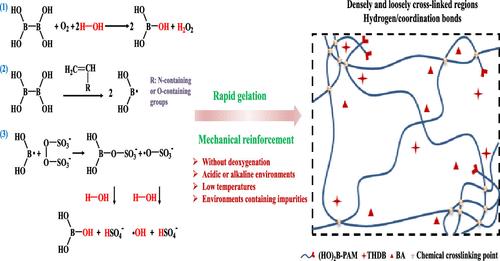四羟基二硼诱导的自由基聚合水凝胶在苛刻条件下的快速凝胶化和机械加固
IF 5.2
1区 化学
Q1 POLYMER SCIENCE
引用次数: 0
摘要
通过自由基聚合制备的水凝胶在大规模生产和实际应用方面前景广阔,但由于聚合过程中的氧气抑制和机械性能较差,水凝胶的制备面临着挑战。这些问题往往需要复杂的结构设计和耗时的厌氧工艺。本研究提出了一种新方法,利用四羟基二硼(THDB)与过硫酸钾(KPS)相结合,在有氧条件下快速生产出机械性能更强的水凝胶,克服了传统的局限性。在环境条件下,THDB-KPS 系统只需 2 分钟就能使丙烯酰胺 (AM) 前体凝胶化,大大优于现有系统。这种方法适用于各种单体类型,包括亲水性、电解质、大分子和齐聚物单体。这种快速凝胶化效果源于 THDB 能够与溶解氧相互作用,中和氧气的抑制作用,并通过乙烯基单体中的 N 或 O 与二硼结构的配位,以均解裂解的方式促进过硫酸盐的有效分解,从而产生 (HO)2B- 自由基。同时,硼引起的氢键和配位相互作用,以及反应体系温度和粘度的快速上升,也有助于缩短凝胶化时间。这些因素还导致形成多种物理交联以及由密集交联区和松散交联区组成的网络。因此,随着物理交联的断裂,这些密集和松散交联区域逐渐变形,水凝胶的机械性能也随之显著增强。即使在酸性或碱性环境、低温和含有杂质的环境等具有挑战性的条件下,这种快速凝胶化和机械增强效果也能保持有效。因此,这一突破为在苛刻条件下生产高性能水凝胶提供了一种可扩展的高效方法,有望在工业应用和不同领域的实际使用方面取得重大进展。本文章由计算机程序翻译,如有差异,请以英文原文为准。

Fast Gelation and Mechanical Reinforcement of Tetrahydroxydiboron-Induced Free Radical Polymerized Hydrogels under Harsh Conditions
Hydrogels prepared through free radical polymerization hold great promise for large-scale production and practical applications but face challenges due to oxygen inhibition during polymerization and poor mechanical properties. These issues often necessitate complex structural designs and time-consuming anaerobic processes. This work presents a novel approach using tetrahydroxydiboron (THDB) combined with potassium persulfate (KPS) to rapidly produce hydrogels with enhanced mechanical properties under aerobic conditions, overcoming traditional limitations. The THDB-KPS system facilitates the gelation of acrylamide (AM) precursors in just 2 min under ambient conditions, significantly outperforming existing systems. This method is versatile across various monomer types, including hydrophilic, electrolyte, macromolecular and zwitterionic monomers. This rapid gelation effect stems from the THDB’s ability to interact with dissolved oxygen to neutralize the inhibitory effects of oxygen, and to promote persulfate decomposition efficiently by homolytic cleavage to produce (HO)2B· radicals through the coordination of N or O in the vinyl monomers with the diboron structure. Meanwhile, boron-induced hydrogen bonding and coordination interactions, along with the fast rise in temperature and viscosity of the reaction system, contribute to the shortened gelation time as well. These factors also lead to the formation of multiple physical cross-links as well as a network of densely and loosely cross-linked regions. Consequently, the mechanical properties of the hydrogel are significantly enhanced through the progressive deformation of these densely and loosely cross-linked regions along with the breakage of physical cross-links. This rapid gelation and mechanical reinforcement effect remains effective even under challenging conditions, including acidic or alkaline environments, low temperatures and impurity-laden environments. Therefore, this breakthrough offers a scalable and efficient method for producing high-performance hydrogel under harsh conditions, promising substantial advancements in industrial applications and practical use in diverse fields.
求助全文
通过发布文献求助,成功后即可免费获取论文全文。
去求助
来源期刊

Macromolecules
工程技术-高分子科学
CiteScore
9.30
自引率
16.40%
发文量
942
审稿时长
2 months
期刊介绍:
Macromolecules publishes original, fundamental, and impactful research on all aspects of polymer science. Topics of interest include synthesis (e.g., controlled polymerizations, polymerization catalysis, post polymerization modification, new monomer structures and polymer architectures, and polymerization mechanisms/kinetics analysis); phase behavior, thermodynamics, dynamic, and ordering/disordering phenomena (e.g., self-assembly, gelation, crystallization, solution/melt/solid-state characteristics); structure and properties (e.g., mechanical and rheological properties, surface/interfacial characteristics, electronic and transport properties); new state of the art characterization (e.g., spectroscopy, scattering, microscopy, rheology), simulation (e.g., Monte Carlo, molecular dynamics, multi-scale/coarse-grained modeling), and theoretical methods. Renewable/sustainable polymers, polymer networks, responsive polymers, electro-, magneto- and opto-active macromolecules, inorganic polymers, charge-transporting polymers (ion-containing, semiconducting, and conducting), nanostructured polymers, and polymer composites are also of interest. Typical papers published in Macromolecules showcase important and innovative concepts, experimental methods/observations, and theoretical/computational approaches that demonstrate a fundamental advance in the understanding of polymers.
 求助内容:
求助内容: 应助结果提醒方式:
应助结果提醒方式:


